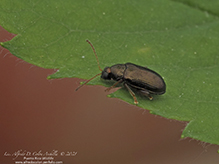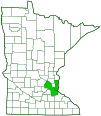potato flea beetle
(Epitrix cucumeris)
Conservation • Description • Habitat • Ecology • Distribution • Taxonomy
|
|
||||||||||||||
Description |
Epitrix cucumeris is one of two beetles that are widely known by the same common name “potato flea beetle”. The other is Psylliodes affinis. Both occur in Minnesota. Historically, Epitrix cucumeris was defined as a widespread species occurring throughout the United States and Canada. A review of the species (Gentner LG, 1944) showed that specimens previously identified as such actually belong to three distinct species. They are very similar and cannot be differentiated in the field by appearance alone. Identifying the species requires both a binocular microscope and a light microscope. However, they can be identified by the damage they cause, and in the U.S. by their geographic location. Epitrix cucumeris as now defined occurs in eastern North America, Epitrix tuberis occurs in the west, and Epitrix similaris occurs only in southern California. Potato flea beetle (Epitrix cucumeris) is a very small, native, leaf beetle. It occurs in North America and in the Caribbean, where it is native, and in the Azores, Portugal, and Spain, where it was introduced. Epitrix cucumeris is a pest of agricultural crops, including eggplant, tomato, potato, pumpkin, squash, gourds, and sweet potato. It is also a pest of tomatoes grown in greenhouses. It feeds on the leaves, chewing numerous minute, circular, 1⁄64″ to 1⁄16″ (0.5 to 1.5 mm) in diameter “shot holes”, which can slow the development, stunt, or even kill a plant, especially a seedling. Epitrix cucumeris larvae live in the soil and feed on the roots of plants in the Nightshade (Solanaceae) family. Adults are active in the spring from late May to early June, and again in the summer from mid-July to mid-August. They feed on the leaves of plants in the Nightshade family, but also on other plants when their preferred plants are not available. Adults are 1⁄16″ (1.5 to 2.0 mm) in length. The body is robust, oblong oval, and black or very dark brown. It is shiny but it does not have metallic reflections. The head is wider than long and shiny. When retracted, it is inserted into the thorax up to the rear margin of the eyes. There are some pits (punctures) near the eyes, each with a single hair (seta). The head is otherwise not punctate. The antennae are brown and have 11 segments. The plate on the upper side of the first segment of the thorax (pronotum) is rectangular, wider than long, and shiny. The front corners are obliquely angled. The lateral margins are moderately toothed (dentate). There is a deep, transverse furrow near and parallel to the rear margin (antebasal depression). The antebasal depression is distinct, deep, and sharply delimited. The surface of the pronotum is pitted (punctate). The punctures are moderately fine, and they are farther apart from each other than their diameters. The wing covers (elytra) are long, completely covering the abdomen. The surface is shiny, has several rows of deep punctures, and is relatively densely covered with long, semi-erect hairs. The legs are brown. The hind legs are enlarged, modified for jumping. The last part of each leg (tarsus), corresponding to the foot, has five segments. The fourth segment is very short and is concealed within the broadened tip of the third segment, making the tarsus appear to have only four segments. The last tarsal segment has a pair of claws at the tip. Each claw has a short wide tooth at the base (appendiculate). |
Size |
Total length: 1⁄16″ (1.5 to 2.0 mm) |
Similar Species |
Habitat |
|
Ecology |
Season |
One generation per year: late May to early June, and mid-July to mid-August |
Behavior |
The adult feeds on both the upper and lower leaf surfaces. It does not fly. It will jump away, like a flea, when a perceived threat approaches its location. This is the characteristic that gives the tribe its common name. |
Life Cycle |
Adults overwinter in the soil or under crop remnants in a state of reduced activity ((diapause). |
Larva Food |
Roots of plants in the Nightshade (Solanaceae) family |
Adult Food |
Mainly plants in the Nightshade (Solanaceae) family, but other plants when those are not available |
Distribution |
||
|
Sources |
|
| 3/22/2024 | ||
Occurrence |
||
|
||
Taxonomy |
|
Order |
Coleoptera (Beetles) |
Suborder |
Polyphaga (Water, Rove, Scarab, Long-horned, Leaf, and Snout Beetles) |
Infraorder |
Cucujiformia |
Superfamily |
Chrysomeloidea (leaf beetles and allies) |
Family |
Chrysomelidae (leaf beetles) |
Subfamily |
Galerucinae (skeletonizing leaf and flea beetles) |
Tribe |
|
Genus |
Epitrix |
Subordinate Taxa |
|
|
|
Synonyms |
|
Epithrix cucumeris Epitrix azorica Haltica cucumeris Haltica seminulum |
|
Common Names |
|
potato flea beetle |
|
Glossary
Elytra
The hardened or leathery forewings of beetles used to protect the fragile hindwings, which are used for flying. Singular: elytron.
Pronotum
The exoskeletal plate on the upper side of the first segment of the thorax of an insect.
Punctate
Dotted with pits (punctures), translucent sunken glands, or colored spots of pigment.
Seta
A stiff, hair-like process on the outer surface of an organism. In Lepidoptera: A usually rigid bristle- or hair-like outgrowth used to sense touch. In mosses: The stalk supporting a spore-bearing capsule and supplying it with nutrients. Plural: setae. Adjective: setose.
Tarsus
On insects, the last two to five subdivisions of the leg, attached to the tibia; the foot. On spiders, the last segment of the leg. Plural: tarsi.
Visitor Photos |
||
Share your photo of this insect. |
||
This button not working for you? |
||
Alfredo Colon |
||
 |
|
|
MinnesotaSeasons.com Photos |
||
|
||
|
||

Slideshows |
|

Visitor Videos |
||
Share your video of this insect. |
||
This button not working for you? |
||
|
Other Videos |
||
|

Created: 3/23/2024 Last Updated: © MinnesotaSeasons.com. All rights reserved. |


